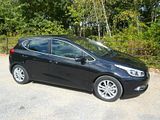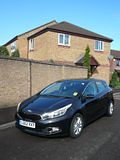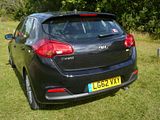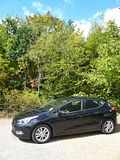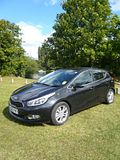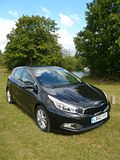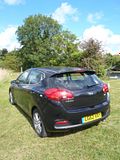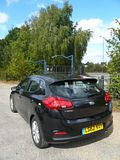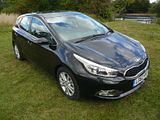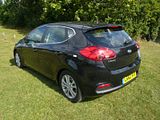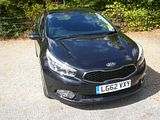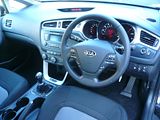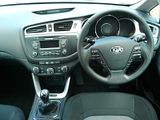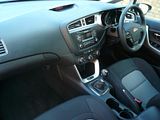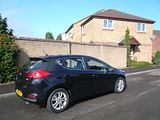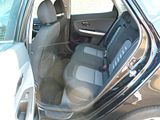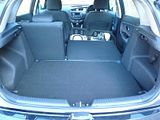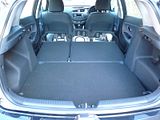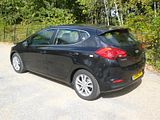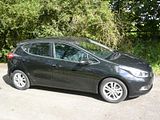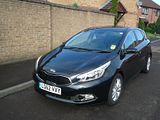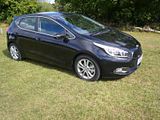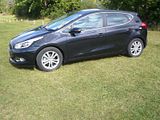Much has been written about the astonishing rate of progress of the Korean car makers. When their cars started to appear in any quantity in Europe in the 1980s the likes of Hyundai, Kia and later Daewoo appeared to be the providers of a lower cost and lower quality alternative to the Japanese, but each successive product was an improvement on the last, with the result that by about ten years ago most of the cars were far better than public perception, and more recently many of the offerings bearing Hyundai or Kia badges could and should be considered in the same breath as the very best cars in class. For Kia it was probably the launch in 2007 of a model designed specifically to meet the tastes and needs of the European market, the C-segment hatchback Cee’d which finally showed that this car maker had “arrived”. Although the most unconventional thing about the Cee’d proved to be its name, since it broke no new ground in terms of styling, engineering or driving dynamics, here was a car that had no significant weaknesses, which coupled with a best in class 7 year warranty made it an attractive ownership proposition. Whilst many still preferred the Golf or Focus, it clearly beat the rather insipid Auris at its own game, and sales were strong. Whether the fact that a brown version of the car appeared in 2012 as the latest “Reasonably Priced Car” on “Top Gear” is probably hard to determine with any accuracy, but it certainly put the brand and the model right in the eye of an awful lot of people. Not content with resting on their laurels, Kia updated the Cee’d during its lifetime, adding the characteristic Schreyer-styled grille to the model in 2010. However, the only way to continue to grow sales volume and take market share, though, is to innovate, so it was no great surprise to find that after just 5 years, Kia had an all new model ready to take on the latest competitors. The second generation Cee’d debuted at the 2012 Geneva Show and went on sale a few weeks later. Examples of the model have already appeared in the Hertz UK fleet, and I was able to get behind the wheel of a 1.6 diesel model to see how the Cee’d has evolved from what was still a perfectly satisfactory car.
Although I sampled a couple of the first generation Cee’ds, both of them were powered by the 1.6 litre petrol engine, so this was my first experience of the similarly sized diesel. It is the larger of two diesel units currently offered in the Cee’d and puts out 126 bhp, just 7bhp less than the petrol model, but with 192 lb/ft of torque as opposed to 121 lb/ft and generated much lower in the rev range, and a far lower emissions rating at just 100 g/km CO2. There are 1.4 litre petrol and diesel cars, as well. Start the Cee’d up and there is still the audible evidence that this is a derv drinker, but it is nothing like the sort of sound one would have experienced a few years ago. Underway, the engine is very quiet and refined, but on some surfaces at least, there was some road roar, which magically disappeared when I was on more recent tarmac. It was not a bad fault, but noticeable only because the engine note and wind were well suppressed. The torque makes all the difference once out and about thought, making this a willing engine which can change from pootling along in traffic to one that can shoot past slow moving vehicles, without the need to work it hard as you would with the petrol powered car. All the manual Cee’ds have a six speed gearbox in this version, and the gearchange is very slick. Unlike some cars where the gearknob itself trades form over function that in the Cee’d is well shaped and pleasant to use. There is quite a long travel between say first and second, but the gate is narrow. Reverse is selected by pressing on the button under the gearknob and always engaged cleanly. What Kia call “Intelligent Stop GO”, or ISG for short, in other words a Start/Stop system is fitted as standard and this was one of the smoothest and fastest operating such systems I have yet encountered, with the engine firing almost as quickly as I could move the gearlever from neutral into first. This feature would no doubt help economy, as well as emission levels, though even without getting much benefit (most of my test mileage was done on the motorway), fuel economy levels were good. I averaged 49.1 mpg, and I know that the car was full both before and after the rental, as I performed both operations. There is a discrete “change up” indicator which like all of its genre is optimised for economy and not performance. The steering is well weighted, perhaps a tad lighter than I would find ideal, but I have to assume that there are an awful lot of customers out there who want it so light that there is no sensation at all (or why would Toyota and others inflict this attribute on us all?) so ensuring that they are not alienated was presumably an engineering consideration. Roadholding and handling were good, with no discernible body roll when the car was driven responsibly on the public road. I doubt it is quite as good as a Focus, but then, what is? The brakes proved rather soft, needing a firm push on the pedal, but once you realised this, there were no issues, and I was delighted to see that (unless you splash out on the 4 or 4 Tech models) Kia have not been seduced by the nonsense around electronic handbrakes being “better” (Audi’s Ad Agency are you listening? they are not “better” for the driver!), with a conventional pullup lever being fitted between the seats. Visibility was not an issue, even though the C panels are quite thick thanks to the third side window line swooping up towards the roof, and the mirrors provided a good field of vision.
Not only has the styling of the Cee’d evolved notably from the first generation, but so has the interior. Look at the dashboard of this generation, and there are strong reminders of Audi, which is probably not a surprise given Kia design lead Peter Schreyer’s heritage. The last model had a simple dash with cowled dials and a raised piece in the centre console for air vents, audio unit and air conditioning switches, but in this model there is a much larger moulding which stretches about two thirds the way across the car, very much like you would find in an Audi, with a brushed silver inlay. It looks a cut above what went in the previous Cee’d and indeed many of its current rivals The three dials, dominated by the speedometer which sits in the middle of the trio are ringed with a chrome strip. They are clearly marked and easy to read. The central air vents have been moved higher and further away from where they could freeze of superheat the driver’s fingers as in the old car. The easy to use audio unit is mounted nice and high, too, where it is readily accessible, though there are repeater buttons for some of the functions on the steering wheel. Below this are three rotary dials for the air conditioning system. It was quite a warm day when I had the Cee’d and the system seemed to struggle to generate cold enough air without setting the fan to its highest speed. Even these dials are higher on the dash than in many cars, leaving room for a tall and deep cubby hole at the bottom of the dashboard. Other functions are largely operated off the two column stalks. The layout is clear and easy to use, and although when you count the nu,ber of buttons on the wheel, there are lots of things to press and touch, it avoids the overly fussy look which so blights the latest Focus. The materials used are all of high quality, too, rivalling Golf in tactile and visual respects.
The driver’s seat adjusts in all the ways you would expect, and combined with an adjustable column, it was easy for me to get comfortable for my test drive. Back seat passengers should not have much to complain about, either. There are class competitive levels of space for them, with decent amounts of legroom, headroom and enough shoulder room for three. The boot is a good size, with more width than you sometimes get in a car of this class. The rear seats are asymmetrically split. The seat cushion lifts up and then the backrests are dropped into the resulting space, creating a long flat load floor. Space for oddments in the cabin is good, with door pockets, a reasonable glovebox, the deep in front of the gearlever, and a deep area under the central armrest. Rear passengers get door pockets and map pockets in the back of the front seats.
Eschewing the trend for ever more ridiculous names to designate model trims, Kia keep things nice and simple with 1, 2, 3, 4 and 4 Tech. The 1.6 CRDi model is available with all of these. The 4 and 4 Tech are geared differently and trade better performance for higher emissions ratings. Otherwise it comes down to personal choice of what equipment you want. There are some visual clues to tell a 1 from other models, as it rides on 15″ steel wheels, whereas the others are on 16″ or 17″ alloys, and it lacks the LED rear lights, chrome window surrounds and the black mesh finish to the front grille. 2 models also bring you electrically folding, heated door mirrors with an obstruction detection indicator feature and kerbside lights, leather wrapped steering wheel, gearlever and handbrake, chrome finishers around the instrument dials, rear electric windows. Upgrade to a 3 and you add rain sensing wipers and lights with “welcome home” feature and rear privacy glass, leather inserts to the seats on the door casings, a gloss black finish to the dash inlay, height adjuster on the passenger seat, dual zone climate control, satellite navigation and a reversing camera. The 4 model comes on 17″ alloys, xenon lights with washers, an electric sunroof on the 4 Tech, leather seats, a 10 way power adjustable driver’s seat, a cursed electronic handbrake, heated seats and steering wheel, and “smart entry” key with stop/start button. The 4 Tech has a parallel parking assist feature. All models have a decent 6 speaker audio unit with CD, MP3, USB and bluetooth capability and a full complement of safety features. Gone are the days when Kia offered bargain basement prices. The entry point for a 1.4 petrol Cee’d 1 may be just £14,395, but the 1.6 CRDi diesels start at £16.295. A 2 spec car like my test vehicle is £18,295 and the 3 retails for £20,095 and the 4 for £21,695. Petrol powered cars are around £1100 less money for the equivalent spec. This is a highly competitive market segment, and these prices are not out of line against the rivals, but I was quite surprised by just how much a family hatch costs these days.
Despite my best efforts to keep uptodate, there are plenty of the Cee’d’s rivals that I have yet to drive, including the latest Focus and Astra which I suspect would still prove to be formidable competition, and the French trio of 308, Megane and C4 which I am pretty sure would not trouble it at all. With a recently launched sister model Hyundai i30 and the yet to go on sale new Auris and Golf, buyers in this class are not lacking choice, nor competence. Which is “best”? Standards are such that you really do need to try each one now, as picking a winner “on paper” is mission impossible. Suffice to say that I thought the Cee’d to be very good. As a car to own and pay for with your own money, it must be about the best, in no small measure thanks to that 7 year warranty, and as a car to drive – as a rental, maybe – well, don’t grimace, as apparently many Hertz customers still do when offered it, as it really will get the job done rather well.


